489
Views & Citations10
Likes & Shares
RESEARCH METHODOLOGY
The research followed a qualitative approach. Conducted a comprehensive study of the literature on causes, symptoms, diagnosis and treatment of breast cancer. Used conference papers and online resources to identify various factors affecting the same.
RESEARCH BACKGROUND
The disease is predominantly diagnosed in women during the menopausal transition; a period often associated with physiological and functional impairments that can affect daily living. A critical molecular determinant in breast cancer is the human epidermal growth factor receptor 2 (HER2), a transmembrane tyrosine kinase protein that regulates cellular growth and repair mechanisms. Overexpression of HER2 leads to HER2-positive breast cancer, which tends to be more aggressive but is amenable to targeted therapies. Conversely, HER2-negative breast cancers lack this receptor overexpression and are generally less responsive to HER2-targeted treatments.
HER2 in breast cancer is divided into dual principal groups: HER2-positive and HER2-negative. Epidemiological analyses suggest that approximately 70% of breast malignancies lack HER2 overexpression, while 15–20% exhibit elevated HER2 levels. Diagnostic evaluation of HER2 status is routinely conducted using immunohistochemistry (IHC) and fluorescence in situ hybridization (FISH), which inform targeted therapeutic approaches. [1,4-6].
Her2-Negative Breast Cancer and Hormone Receptor Classification [6,7]
HER2-negative breast cancer refers to tumors that do not exhibit overexpression of the human epidermal growth factor receptor 2 (HER2), a transmembrane tyrosine kinase involved in cellular proliferation and repair. Within the HER2-positive category, further subclassification is based on hormone receptor (HR) status-specifically the presence or absence of estrogen receptors (ER) and progesterone receptors (PR). These biomarkers are critical in determining tumor behavior and guiding therapeutic strategies.
HER2-positive breast carcinomas are further subclassified based on hormone receptor expression, specifically the presence or absence of estrogen and progesterone receptors, into two major subtypes: hormone receptor-positive (HR+) and hormone receptor-negative (HR−) [8,9].
HER2-Positive Breast Cancer [10].
- HR-Positive (68%): Tumors express estrogen and/or progesterone receptors. Hormone binding promotes tumor growth.
- HR-Negative (10%): Tumors express HER2 but lack hormone receptors. These are generally more aggressive and are treated primarily with HER2-targeted therapies.
- HER2-Negative Breast Cancer
- May not respond to HER2-targeted therapies but can be treated with other modalities.
Hormone receptor status is determined through immunohistochemistry (IHC) testing, which evaluates the presence of ER and PR proteins on tumor cells. The absence of these receptors classifies the tumor as hormone receptor-negative (HR−), while their presence indicates hormone receptor-positive (HR+) status. Epidemiological data show that approximately 9.4% of breast cancer cases are HR+/HER2+, while 3.9% are HR−/HER2+. This classification plays a pivotal role in prognosis and treatment planning, as HR+/HER2+ tumors tend to have more favorable outcomes due to the availability of dual-targeted therapies [6,8] (Figure 1).
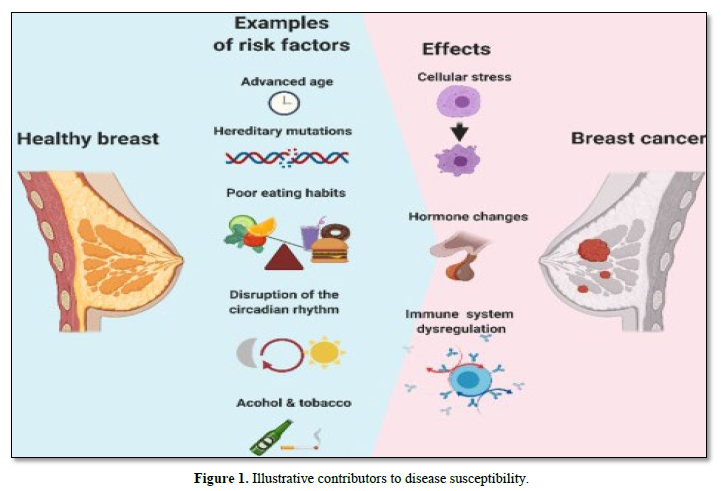
Subtypes of Mammary Neoplasms Based on Cellular origin and Molecular Profile (Table 1 & Figure 2)
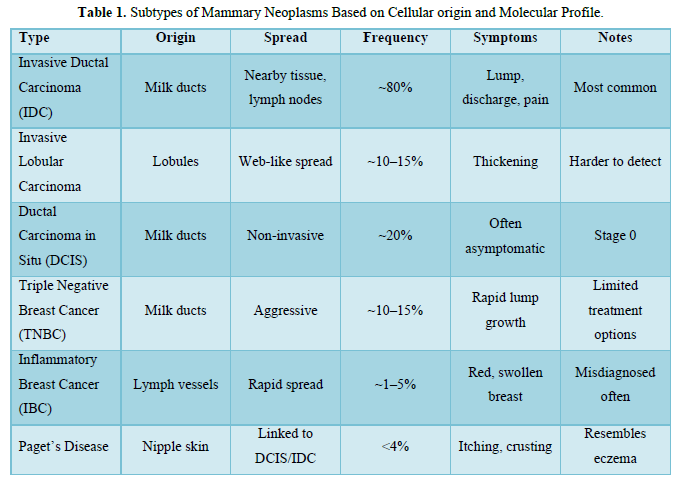
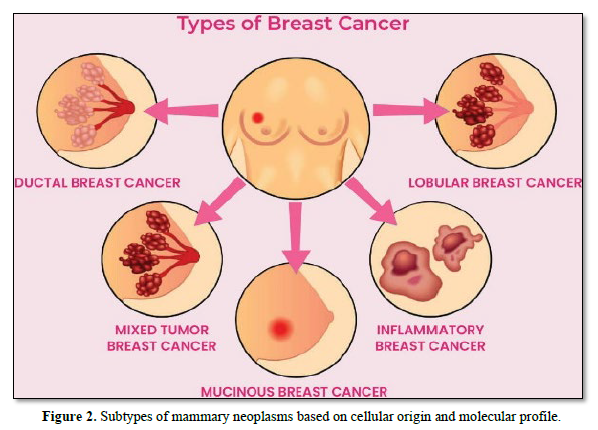
Stages of Breast Cancer [13] (Figures 3 & 4)
- Stage 0: DCIS, non-invasive
- Stage I: Small tumor, limited lymph node involvement
- Stage II: Larger tumor, lymph node spread
- Stage III: Locally advanced, chest wall/skin involvement
- Stage IV: Metastatic, distant organ involvement
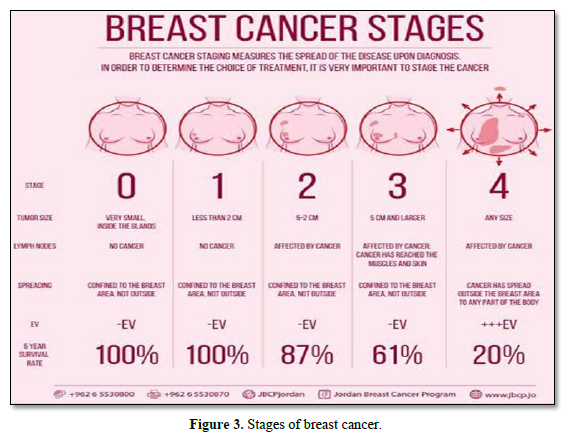
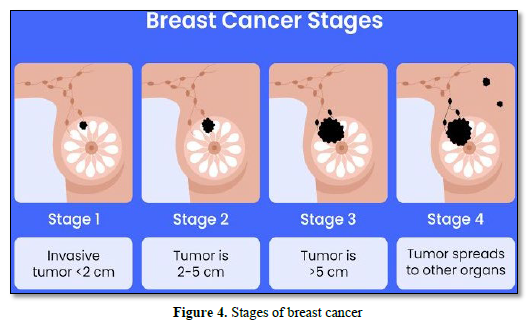
Epidemiology of Breast Cancer (2020-2024): [14] (Table 2 & Figures 5 & 6)

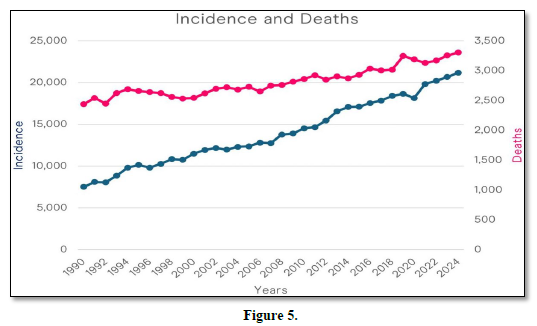
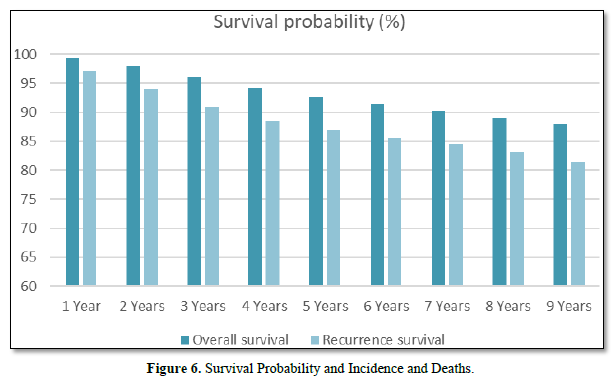
Key Epidemiological Indicators Associated with Disease [16] (Figure 7)
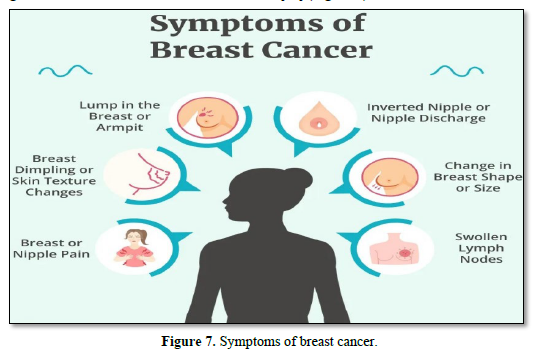
- A palpable mass or localized thickening within the breast tissue that differs in consistency from surrounding areas.
- Inversion or retraction of the nipple.
- Alterations in breast skin pigmentation or tone.
- Change in the breast’s shape, volume, or symmetry that deviate from its usual appearance.
- Textural changes in the breast skin, such as dimpling or a rough surface resembling an orange peel.
Underlying Biological and Environmental Determinants of Breast Cancer onset [17] (Figure 8)
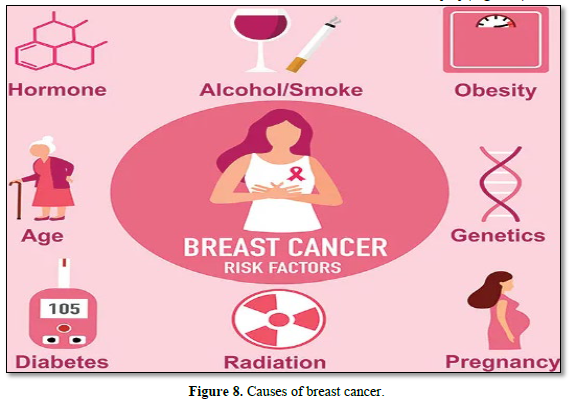
- Smoking: The use of tobacco is associated with different kinds of cancer, including breast cancer.
- Studies indicate that consuming alcoholic beverages may increase the risk of breast cancer.
- Having obesity.
- Exposure to radiation: If you have undergone previous radiation therapy, you are at a higher likelihood of.
Categories of diagnostic screening modalities [19] (Figure 9)
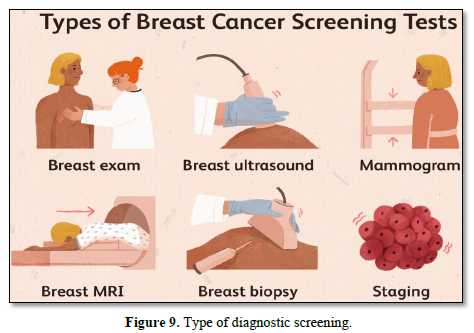
- Breast ultrasonography-a non-invasive imaging test that use high-frequency sound waves to visualize internal breast structures and detect abnormalities.
- Magnetic resonance imaging (MRI) of the breast is a diagnostic test that utilizes magnetic fields and radio waves to generate cross-sectional images of breast tissue.
- A histopathological examination via breast biopsy is a process that entails gathering tissue samples for microscopic analysis to confirm the existence of cancerous cells.
- Genetic screening for oncogenic mutations – laboratory technic designed to identify genetic alterations, such as BRCA1 and BRCA2, that increase the risk of developing breast cancer.
Immunohistochemistry Test (IHC): Determine to HER2 Receptors are present or not [34].
Fluorescence in Situ Hybridization (FISH) Test: To detect the presence of HER-2 extra copies and for identification determine positive or not [35].
Treatment Options [21] (Figure 10)
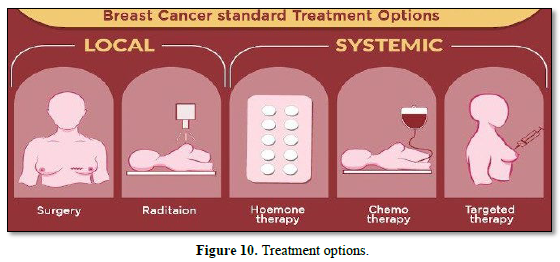
- Surgery: Mastectomy, lumpectomy, reconstruction
- Therapies: Chemotherapy, radiation, immunotherapy, hormone therapy, targeted therapy
- Drugs:
- Herceptin (HER2+)
- Tykerb (HER2+)
- Ibrance (ER+)
- Piqray (ER+)
- Lynparza, Talzenna (BRCA mutations)
- Datroway (HR+, HER2−)
Proactive Measures [24] (Figure 11)
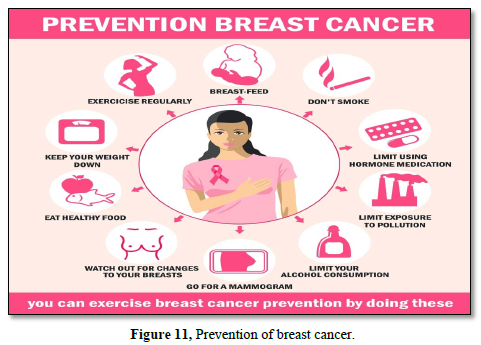
- Maintain healthy weight
- Eat a balanced diet
- Avoid alcohol
- Stay active
- Limit hormone therapy
- Quit smoking
Global Impact & Who Response [14]
- 40% reduction in mortality in high-income countries (1980-2020).
- WHO aims to reduce global mortality by 2.5% annually through early detection, timely diagnosis, and comprehensive care?
CONCLUSION
Breast cancer remains a multifaceted disease with significant global health implications, particularly among women in transitional life stages such as menopause. The classification of breast cancer based on HER2 receptor status-HER2-positive and HER2-negative-has revolutionized diagnostic precision and therapeutic strategies. HER2-positive tumors, though often more aggressive, benefit from targeted treatments, while HER2-negative and triple-negative subtypes present greater clinical challenges due to limited therapeutic options.
The integration of hormone receptor profiling, molecular diagnostics like IHC and FISH, and advanced imaging techniques has enhanced early detection and personalized care. Epidemiological trends from 2020 to 2024 reveal both rising incidence and evolving survival outcomes, emphasizing the importance of proactive screening and equitable healthcare access [14].
Treatment modalities continue to expand, encompassing surgery, chemotherapy, hormone therapy, and targeted drugs such as Herceptin, Ibrance, and Lynparza. Preventive strategies-ranging from lifestyle modifications to genetic screening-play a crucial role in reducing disease burden. Global initiatives, including WHO’s efforts to reduce mortality through early detection and comprehensive care, underscore the need for sustained research, awareness, and policy support [6,14].
This review highlights the critical role of HER2 receptor classification in guiding clinical decisions and improving patient outcomes, reinforcing the value of molecular profiling in modern oncology.
- Eldrige L (2025) Avoiding Cancer One Day at a Time.
- Doherty is a board-certified internist and writer living with multiple sclerosis. She is based in Chicago. Colleen Doherty, MD, Internal Medicine | Chicago, IL | WebMD
- Welsh is a Connecticut-based freelance science and health writer with a graduate certificate in science communication from UCSC.
- Iqbal N, Iqbal N (2014) Human epidermal growth factor receptor 2 (HER2) in cancers: Overexpression and therapeutic implications. Mol Biol Int 2014: 852748.
- https://www.cancer.org/cancer/types/breast-cancer/understanding-a-breast-cancer-diagnosis/breast-cancer-hormone-receptor-status.html
- https://www.breastcancer.org/about-breast-cancer
- Cancer Genetics and Risk Evaluation | Penn Medicine
- https://pubmed.ncbi.nlm.nih.gov/23908178/
- https://www.researchgate.net/figure/Molecular-classification-of-breast-cancer-subtypes-Breast-cancer-can-be-divided-into_fig2_357239665
- https://www.cancer.org/cancer/types/breast-cancer/about/types-of-breast-cancer.html
- https://Breastcancer.org/Genetics
- https://CentersforDiseaseControlandPrevention/Diagnostic
- https://www.cancer.org/cancer/types/breast-cancer/understanding-a-breast-cancer-diagnosis/stages-of-breast-cancer.html
- https://www.who.int/news-room/fact-sheets/detail/breast-cancer
- https://www.breastcancer.org/screening-testing/ihc-immunohistochemistry-tests
- https://www.cancer.org/cancer/types/breast-cancer/treatment/surgery-for-breast-cancer.html
- https://www.nationalbreastcancer.org/causes-of-breast-cancer/
- Breast Cancer Signs and Symptoms | American Cancer Society
- https://www.cancer.org/cancer/types/breast-cancer/screening-tests-and-early-detection.html
- https://www.cancer.org/cancer/types/breast-cancer/treatment/hormone-therapy-for-breast-cancer.html
- https://www.cdc.gov/breast-cancer/treatment/index.html
- https://www.cancer.org/cancer/survivorship/coping.html
- https://www.who.int/news-room/fact-sheets/detail/breast-cancer
- https://www.cdc.gov/breast-cancer/prevention/index.html
- https://www.breastcancer.org/types/metastatic#section-what-is-metastatic-breast-cancer
- https://www.cdc.gov/breast-cancer/
- https://WWW.cancer.gov?types/breast?redirect=true
- Begum H (2025) International Cancer Burden Analysis 2020-2024: GLOBOCAN-Derived Estimates of Incidence and Mortality for 30 Malignancies in 190 Geographic Regions. Am J BioMed 13(1): 1-18.
- WebMD (2024) HER2-Negative vs. HER2-Positive Breast Cancer. Available online at: https://www.webmd.com/breast-cancer/her2-negative-vs-her2-positive
- Healthline (2024) HER2-Positive vs. HER2-Negative Breast Cancer. Available online at: https://www.healthline.com/health/breast-cancer/her2-positive-vs-her2-negative
- Esserman LJ, Joe BN (2023) Diagnostic evaluation of suspected breast cancer. UpToDate. Available online at: https://www.uptodate.com/contents/diagnostic-evaluation-of-suspected-breast-cancer
- SEER (2025) Female Breast Cancer Subtypes-Cancer Stat Facts. National Cancer Institute. Available online at: https://seer.cancer.gov/statfacts/html/breast-subtypes.html
- American Cancer Society (2025) Breast Cancer HER2 Status. Available online at: https://www.cancer.org/cancer/types/breast-cancer/understanding-a-breast-cancer-diagnosis/breast-cancer-her2-status.html
- https://www.cancercenter.com/diagnosing-cancer/diagnostic-procedures/immunohistochemistry
- https://www.cancercenter.com/search#q=FLUORESCENCE%20IN%20SITU%20HYBRIDIZATION%20(FISH)%20TEST&sort=relevancy
- Li YW, Dai LJ, Wu XR (2024) Molecular characterization and classification of HER2-positive breast cancer inform tailored therapeutic strategies. Cancer Res 84(21): 3669-3683.
- World Health Organization (2025) Breast cancer fact sheet.
- World Health Organization (2021) Global Breast Cancer Initiative. Available online at: https://www.who.int/initiatives/global-breast-cancer-initiative
- American Cancer Society (2023) Recommendations for the early detection of breast cancer.
- Grosse C, Noack P, Grosse A (2025) Prognostic impact of HER2-low expression in triple-negative breast cancer. PLoS One 20(6): e0325715.
QUICK LINKS
- SUBMIT MANUSCRIPT
- RECOMMEND THE JOURNAL
-
SUBSCRIBE FOR ALERTS
RELATED JOURNALS
- International Journal of Internal Medicine and Geriatrics (ISSN: 2689-7687)
- International Journal of Radiography Imaging & Radiation Therapy (ISSN:2642-0392)
- Journal of Carcinogenesis and Mutagenesis Research (ISSN: 2643-0541)
- Journal of Allergy Research (ISSN:2642-326X)
- Journal of Pathology and Toxicology Research
- Journal of Infectious Diseases and Research (ISSN: 2688-6537)
- International Journal of Medical and Clinical Imaging (ISSN:2573-1084)













